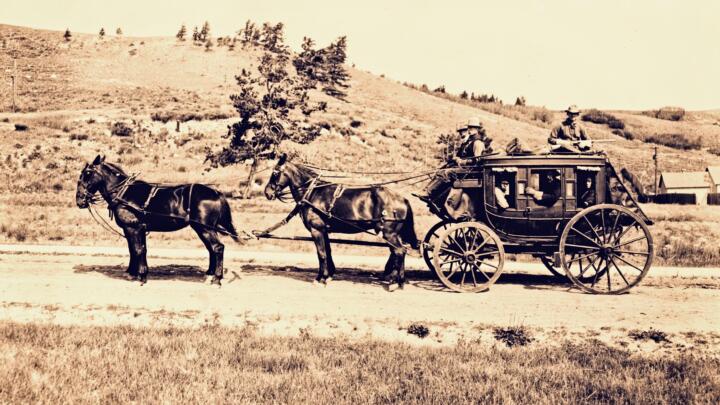
Directly to your door!
3000 BC a couple of clever minds in Ancient Babylon notice that symbols can be scratched into clay tablets, enabling news to be transmitted word for word across even longer distances. A few centuries later, the pharaohs in Ancient Egypt will use extremely thin papyrus scrolls to send their written decrees to the remotest corners of their empire. The plant-based writing material has the advantage of being easier to write on, furlable and therefore facilitating transportation. In addition, the Egyptian god kings establish an initial form of postal operations using sailing boats on the Nile to carry important dispatches quickly across long distances at regular intervals.
The Chinese deserve credit as postal pioneers as well for having set up the first distribution network with relay stations around 1000 BC. In the 6th century BC, Cyrus’ Persian empire uses a messenger relay system as well with horsemen riding from postal station to postal station. This system has been described in detail by the Greek historians Herodotus and Xenophon.
A fast flow of news is a key pillar of preserving power in the huge empires of antiquity, especially in the context of military operations. For faster transportation of the written message, the Romans under Emperor Augustus (63 BC to 14 AD) establish the cursus publicus – the first state-mandated postal system. Couriers on horseback carry letters from political and military leaders into all corners of the empire. Tired horses can be replaced every few miles at change stations.
Postal services for everyone
For centuries, postal services remain a privilege of the wealthy and powerful. Letters become an increasingly important form of communication for merchants as well only in the 15th century when cheaper paper is introduced as a writing material. In the course of the following centuries, more and more private citizens make use of the opportunity to correspond with others by means of postal couriers.
Riding high and fast

The Butterfield Overland Mail Company was the first regular stagecoach service operating across the United States. It was intended to help improve the supply of information to remote areas in the American West and to drive westward settlements in that way – a similar consideration as today’s efforts to expand internet coverage and fiber-optic networks. On September 15, 1857, the first stagecoaches took off from St. Louis in the East and San Francisco in the West. The stagecoach from San Francisco arrived in St. Louis after 23 days and four hours carrying mail and six passengers. Initially, the stagecoaches traveled the 4,555-kilometer (2,830.4-mile) route twice a week. Every Monday and Thursday they’d set off from their departure points in the East and West with passengers, goods and up to 12,000 letters on board. A one-way passenger ticket sold for a whopping 200 U.S. dollars. At times, the company employed more than 800 people and operated more than 130 stations. Increasingly frequent robberies, the impending civil war and, ultimately, the triumph of the railroad led to the demise of the service as early as in 1861.
The transportation of mail picks up pace with each technological evolution. Stagecoaches are replaced by trains and air mail accelerates deliveries further. Even rockets as couriers traveling at the speed of sound are used in experiments.
The faster and cheaper deliveries become, the larger the number of letters and parcels being dispatched. As a result, the distribution centers can’t keep up with all the sorting work, not least due to technological progress failing to make inroads into the centers for a long time. Merely the simplest of tools such as sorting tables, racks and pockets facilitate the work until far beyond the first half of the 20th century.
Humans vs. machines
Only in the mid-nineteen-fifties, the U.S. Postal Service as a global trailblazer starts relying on assistance by machines for channeling the flows of mail. In 1956, the first semi-automatic mail sorting machine is put into service in Baltimore. A year later, on April 10, 1957, a Transorma Letter Sorting Machine starts operating at the Blair Post Office in the state of Maryland. Using the two-story behemoth with a height of nearly four meters (13 feet) from the Dutch manufacturer Werkspoor, five postal workers are able to sort up to 15,000 letters within the space of one hour – more than twice as many as previously by hand.
1978 marks another milestone of progress when the first automatic mail sorting system with address recognition and video encoding is installed in Wiesbaden, Germany: a technology that will be subjected to continuous refinement in subsequent years. Today, all fully automatic large-scale sorting machines worldwide operate with text recognition programs. The seemingly simply process of sorting by now entails perfectly coordinated interaction of mechanical, optical and digital technologies.
In the pre-processing stage, mail items of various sizes are initially scanned and divided into two groups: can the machine read the address or not? If not, the mail item is segregated for manual data acquisition. Items with readable addresses are subsequently aligned, and recognized postage stamps automatically postmarked. Afterwards, the zip code is identified using OCR (Optical Character Recognition) software, and the letter forwarded on conveyor belts to the compartment for the matching destination: as fast as possible, because time is money and recipients would like to have their mail reach them within 24 to 48 hours.

Dizzying statistics
The volumes to be sorted are humongous. The number of letters mailed per day has hardly subsided even in the digital age. 14 billion letters mailed in 2020 make the United States the definite front runner in this context, with 90 percent of them accounting for marketing materials – a phenomenon all of us can arguably relate to considering the content of our own mailboxes. While the number of letters has remained on a constantly high level in nearly all industrial nations in recent years, the parcel delivery statistics have virtually been skyrocketing due to online shopping. Last year, 131 billion parcels were sent worldwide, according to the “Parcel Shipping Index” published by technology solutions provider Pitney Bowes. By comparison, the number of parcels shipped in 2014 was 43 billion.
656,000
traditional post offices employing 5.23 million people are still in existence worldwide.
Source: Postal Development Report 2020
Even though a couple of snug post offices may still exist here and there in the middle of nowhere, today’s mail carriers are global players in the field of logistics. Simple postal routes have evolved into complex distribution networks. Outbound mail is collected in huge distribution centers and sorted for national and international dispatch.
Just looking at the statistics of UPS Worldport is a dizzying experience. In Louisville, Kentucky, the American parcel service operates the world’s largest parcel and distribution center in an area of 48 hectares (5.2 million square feet). The sorting hall alone, where more than 400,000 parcels – per hour! – are allocated to their respective recipients, measures more than 200,000 square meters (2,153 square feet). Supporting the processes is a seemingly endless multi-story maze of 33,000 conveyor belts with a total length of 250 kilometers (155 miles), hundreds of optical scanners, and switches. During the entire distribution process at Worldport a parcel comes into contact with human workers just twice: while being unloaded from inbound containers and while being loaded onto outbound containers.
Smart safety
It’s easy to imagine what would happen if just one of the conveyor belts, just one of the switches, in one these high-tech distribution centers ground to a halt. An unforeseen defect would cause a massive number of parcels and letters to pile up. In the worst case, this would lead not only to negative headlines but also to financial penalties due to delayed deliveries.
To prevent such failures, machine operators replace components far ahead of having reached their wear limits just to be on the safe side. That costs money and resources. But as the saying goes: better safe than sorry. And, honestly, who can tell when a component will actually break down? The answer used to be: no one. Today, condition monitoring systems are available for exactly these types of predictions.
Royal Mail, the national postal service in the United Kingdom as well as a global player, for instance, relies on Schaeffler’s SmartCheck to minimize the cost-intensive risk of failures. The online measuring system at Royal Mail monitors and analyzes the work processes of the carousel sorting machines at vulnerable points. As a result, not only unnecessary maintenance costs and spare parts worth 50,000 pounds sterling have been saved per year but the failure rate of important drive components has dropped significantly as well. This has resulted in fewer disruptions, a more fluid supply chain and satisfied customers. After all, nobody enjoys a long wait for an eagerly expected letter or parcel of merchandise they’ve ordered.










